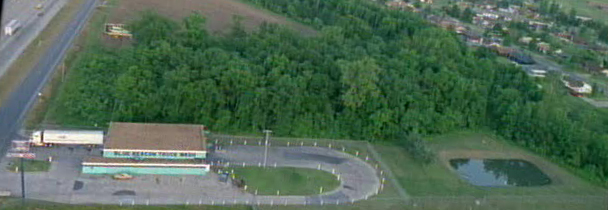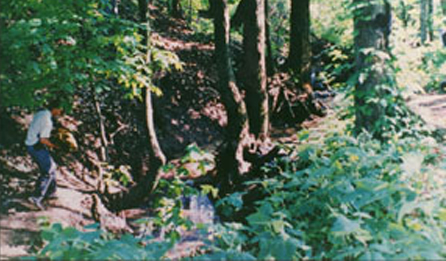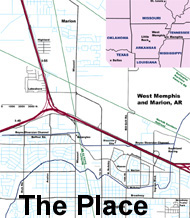
The Blue Beacon and the discovery woods
I called the Sheriff's Department the second time. I said, look, I've had one police officer out here helping me look for these boys. . . I said, it's 11 o'clock at night [May 5]. They're not at somebody's house. He said, well I tell you what to do. If they don't come home tonight, he said, you get a hold of Denver Reed. And I said, well, who's Denver Reed. He said, he's head of the Search and Rescue Force. [John Mark Byers, May 19, 1993 interview]
Day of Discovery
Before Dawn.
The 3 to 11 shift on May 5th had ended. The missing person reports had been taken and two officers had logged some time looking for the children. With the late night shift, there would also be little police involvement in the search. The only entries in the log books referring to the search of the children would come from Lt. Fred Boskey and Officer John Slater. The first came at 5:26 a.m. at the dead end of McAuley near where the bikes were later found. This was followed at 6:01 by what was described on the dispatch sheet as along the North Service Road and Sycamore in a "little patch of woods." There is nothing corresponding to a Sycamore Drive near the Service Road. They are then listed as searching the area behind the Blue Beacon from 6:12 to 6:28 a.m. Since Slater would later describe his search efforts as beginning at the footpath to the pipe across the bayou and continuing from there to the woods behind the Blue Beacon, it is likely that these three sites were part of a contiguous search and the Sycamore Drive entry a mistranscription.
In an affidavit describing these search efforts, Slater said
Lt. Boskey and I then drove to the end of McAuley Drive West, to the point at which the street ends and a footpath leads to a pipeline crossing the diversion of Ten Mile Bayou. Lt. Boskey and I followed the footpath to the pipe and crossed the diversion of Ten Mile Bayou and searched it thoroughly for approximately 30 minutes. Lt. Boskey and I specifically searched the area of the large ditch running into the bayou. I am aware that this is the location where the bodies of the three victims were found later in the day on May 6, the same day we thoroughly searched the area. At the time Lt. Boskey and I searched that area, the bodies of the victims were not present in the ditch. If the bodies had been present at the time we searched the area, I am confident we would have located them. We were thoroughly examining every part of the area, including every part of the ditch feeding into the bayou, and were assisted by our heavy-duty flashlight and the fact that some predawn light was also available. [Sunrise came at 6:05] I did not communicate this information to the detectives investigating the murders. I did, however, speak with Lt. Boskey on other occasions about our personal knowledge that the bodies of the victims were not present at that location during the time period when we searched. [Affidavit, John P. Slater, February 20, 2001]
This statement is troubling in how it conflicts with the proposed and common sense timeline of the case: that the bodies were in the woods before sunrise when the massive search effort would begin to saturate the area. However, Slater's conclusions are based on "negative evidence;" the lack of sighting of the bodies is not the equivalent to the bodies not being there.
With the police being of little help, the families continued their searches. Statements were not taken at the time and only recently have become available from the Hobbses or the Branch family regarding their searches that night. Todd Moore, the father of victim Michael Moore, was away on a trucking run and wouldn't return until morning. Mark Byers described his efforts late that night alone and with his friend, Tony Hudson. In one statement he described searching until 2 or 3 a.m., in another, until 4:30. He said he then went home but didn't sleep.
Morning, May 6, 1993
According to Mark Byers, early in the morning, he encountered the other parents of the missing children at the Seventh Street Bridge where it crossed over the bayou, near Pamela Hobbs workplace, Catfish Island. Todd Moore, Steve Branch, Sr. and Terry Hobbs had just come back from scouring alongside the bayou to the west. Mark Byers chose to go east, to return to the area near the Blue Beacon where he had been the night before.
I said, well I'm going to go back down, and I said I'm going to go back around the area where I was last night. Maybe I missed something. Maybe there's a cap or a piece of clothing or something I didn't see. So I went down there and then I noticed uh, the Search and Rescue, we had already met with uh, Denver Reed and 8 o'clock (sic). [John Mark Byers, May 19, 1993 interview]
The Search and Rescue squad was finally involved in the hunt. The Crittenden County Sheriff Department offered this explanation for the delay. "They could have used some help; hell, yes, they could have used some help," he said. Sheriff Richard Busby said Thursday night he talked with the dispatcher and sergeant on duty the previous night and said there was miscommunication between his officers and Byers. The officers said Byers wanted to know if "this was the right place to call to get a report made out," the sheriff said. "They said no, you need to call the city police department." Busby, who said he knew Byers and considered him a friend, said "if anyone had called us last night, we'd have been glad to have helped them. We didn't get a call from West Memphis (police) or anyone." [Memphis Commercial Appeal, May 7, 1993]
At 8 a.m., the police were meeting in their assembly room to plot a strategy. Inspector Gary Gitchell was in charge. Every available officer was assigned to finding the children.
The search was in full swing. At 9 a.m., a helicopter came over from Memphis to hunt from the sky. It stayed aloft for two hours until it had to return for fuel. A john boat was employed to scour the bayou - and would eventually encounter the bicycles. Bryan Woody, who would testify as to last seeing the children would be searching the meadows and woods using an all-terrain vehicle as would Bo Hamrick, Tony Smith and Detective Bryn Ridge. Others would be looking on foot and on bicycle. Gitchell would estimate: "there were 50 searchers, including police, volunteers from the Crittenden County Search and Rescue Squad and the boys neighborhood." [May 7, 1993, West Memphis Evening Times]
Convergence
The discovery of the children occurred in a stepwise fashion. First, an item of clothing was seen in a ditch. Then, the police were called in. One officer, plunging into the water, encountered a victim. Finally, another would sweep along the ditch to find the other two. Six individuals who converged on the area, one after the other, would play different roles in the unfolding of the day's events: Steve Jones, the juvenile probation officer assigned to Jason Baldwin, who was assisting in the search; Denver Reed, head of Search and Rescue; Seargent Michael Allen who, together with Officer George Phillips, would be the first police called to the scene; Officer Diane Hester who would take the early photos, and Detective Bryn Ridge who would recover the victims from the water.
Jones and Reed
Steve Jones, then 36 years-old, was described as about 5 foot 10, wiry and balding. He worked under Jerry Driver as an assistant juvenile probation officer. Along with Driver, he took a special interest in the occult and together they patrolled the county on nights with a full moon, trying to prevent satanic sacrifices.
Jones had been assigned to Jason Baldwin after Baldwin had vandalized some old cars. Jason Baldwin later recalled, "Steve Jones would hound me for wearing rock and roll T-shirts and the like. [snip] He absolutely hated Damien. He told all the kids in the neighborhood that Damien was a Satan-worshiping faggot." [Devil's Knot, page 359] Jones had also been assigned to Domini Teer.
The only police documents regarding Jones are related to his pursuits of Echols and the cult. Dixie Hufford, Narlene Hollingsworth aunt passed along this:
Heard F/Steve Jones Jerry Driver heard about devil worshipping. [Hufford notes, May 20, 1993]
Steve Jones wrote up notes of his interviews with Garrett Schwarting about Damien Echols and others in the "Satantic" or "santanic" cult.
Garrett Swording began to tell me about Damien Echols, having a demon inside of him that was place there by a man called Lucifier. He Garrett Swording stated this demon that had possessed Damien Echols must kill nine people before it could become a God. Garrett Schwarting stated the first person he was suppose to kill was Jason Baldwin. [Steve Jones, June 10, 1993]
From Jones' notes, Schwarting stated Baldwin was a part of the cult, but also gave him an alibi, saying he was with Jason on the night of the murders. In contrast, when interviewed by the police, Schwarting said he knew of only one person who was definitely in the cult, a "Lusserfur," although he had never seen him.
Jones would play a crucial role and yet there is no official account of his discovery of the victims and he was not called on to testify at trial. The only police notes regarding his activities that day come from the dispatch logs, (after 9:35 a.m. entry) "Steve Jones (Disreguard)" and a brief reference in the Crime Scene Notes. "Thurs. May 6th, 1993- 1:45 P.M. - Steve Jones - Mike Allen Locate 1st Body"
Denver Reed, a deputy sheriff, was sixty years old and head of the volunteer Crittenden County Search and Rescue, nine of whom would join in the search. Mark Byers stated, "I had already known to meet Denver Reed cause I had talked to him like 6:30, 7 and I think he said 8:30, 9 o'clock meet me at Ingram and Barton and we'll get this search going. So we met down there and then some of the Search and Rescue trucks had pulled up." [John Mark Byers, May 19, 1993 interview] (This conflicts with the above cited statement where Byers describes encountering Reed near the Blue Beacon at 8 o'clock.)
Again, although he was at the scene at the time of discovery, there is no official documentation of Reed's role beyond a brief reference during the trials. Baldwin attorney Paul Ford, cross-examining Seargent Mike Allen:
Ford: Who - who was there with you when - who did you meet there who were law enforcement officers at that location?
Allen: Denver Reed, which is a Deputy Sheriff also on the Crittenden County Search and Rescue, was coming out of the woods. I met him as I was going into the woods. Steve Jones who is a juvenile officer was at the location that had observed the shoe and I guess him and Denver were in that area at that time searching. [Echols/Baldwin trial]
Allen would later recount to the authors of Blood of Innocents [p. 416]:
". . .Jones and Denver Reed of the Crittenden County search and rescue squad were both present when he [Mike Allen] entered the woods. "I don't know that it was him (Jones) or Denver that actually saw the shoe," Allen said.
Phillips and Allen
There are no entries into the police log describing the actions of Officer George Phillips between nine a.m. and noon. At 12:05 p.m. he called in from Action Motors on 14th near Broadway. This was followed immediately by transport to the police station. At 12:16 he reported his whereabouts at 14th and Barton, where the Moores and Byers lived, and then at 12:42 p.m. he called from Weaver Elementary. At 1:14 pm he received a call to report to WE Catt and West McAuley in reference to the missing children. Officer Phillips was a neighbor of victim Steve Branch, having lived three doors down from him. There are no statements or testimony from Phillips regarding his role in the discovery.
Seargent Mike Allen, a veteran of five years on the force, attended the eight a.m. police briefing. He was assigned the task of obtaining a list of vacant houses from the utilities department and checking them out. Before getting the list he visited Maddux Elementary with Detective Diane Hester at 9:48 a.m. to talk with Jeff Sereal, a student who said he saw three boys head into a house. There are no notes of the follow-up. At 10:49 he picked up the utilities list from George Weatherspoon. There are no notes of the vacant houses he visited. The search efforts notes place him at Bill's Grill and at a pumping station on S. McAuley at unspecified times. At the Misskelley trial he explained how he came to the discovery site.
Fogleman: Okay. And, at some point in your searching, did you receive some dispatch of some need to go to another area?
Allen: I was informed to go to the area of the end of... it's West McCauley. The North end of West McCauley, the dead end.
In his testimony in the Echols/Baldwin trial, he made it clear the call was not directed to him.
Allen: There was a call that came out over the radio that was directed to 249, which is George Phillips a officer with the West Memphis Police Department - a uniformed officer, um - I don't really remember anything other than they wanted George Phillips uh - dispatch called and asked that George Phillips meet a county officer at the dead end of West McAuley. [Echols/Baldwin trial]

Seargent Mike Allen near the discovery site.
Hester and Ridge
Like Allen, Lieutenant Diane Hester spent the morning visiting schools and vacant houses. With Allen, she visited Maddux Elementary at 9:48 a.m. She visited Weaver alone at 12:21 p.m. She did not testify at trial and there is no official statement detailing her actions that day and there is no statement as to how she came to be on scene at the time of the discoveries. Presciently, she began taking photos even before the discovery was made.
Detective Bryn Ridge testified he was informed of the missing children at 7:30 a.m. He began his search at the discovery site. At 7:45 in the morning, he went to the dead end of McAuley and met Steve Branch, Sr. Crossing the pipe, Ridge said he encountered several people, looking around the woods, "hollering, searching," including one teenager with a bike.
After this, he headed west on foot until he got to Seventh Street and then circled back. He searched to the east ". . . this big wooded area here that, this is just a big thicket there are no paths really that go through it, you just have to dig your way through the vines." [Ridge, Misskelley trial]
Ridge went home to get his three-wheel all-terrain vehicle. Using this, he searched an area far to the west of the discovery woods. At 1:05 p.m., he called in, South of Lakeshore.
The Curious Day of Officer Billy Sanders
Officer Billy Sanders was part of the crime scene detail. His story is fascinating as he would be present at most of the significant sites, including those that wouldn't be significant until later.
- 8:26 a.m. 2700 S. Grove in reference to a black male in a car. Echols lived at 2706 S. Grove.
- 8:54 At the ditch at the entrance to the Robin Hood Woods where Bryan Woody testified the children were last seen.
- 9:05 1120 WE Catt, a vacant house next door to where Otto Bailey stated he last saw the children.
- 9:20 North Service Road near Flash Market and under Missouri Bridge.
- 9:22 (Noted with Patrolman Reese. Entry blank)
- 10:39 Patrolling the Mayfair Apts on foot, near where the bicycles were found.
- 1:08 p.m. Six minutes before Phillips and Allen were called to the scene by Jones, Sanders was dispatched to the Blue Beacon in reference to an accident on the entrance ramp. (Only two accidents are noted during the 7 to 3 shift.)
- 2:43 Crime scene detail.
Another odd connection of Sanders to the case is the fact he was a nearby neighbor of the Hobbs family at their previous address on West Danner. Pamela Hobbs family and the Sanders family are both from Osceola, Arkansas.
On September 11, 2008 Billy Sanders resigned from the West Memphis police department due to pending charges of "sexual indecency with a child, furnishing alcohol to minors, and terroristic threatening." [WMC-TV, Memphis, October 30, 2008]. He is alleged to have used his police-issued cell phone to send messages to a 14-year old girl demanding money and sex. "Sanders is also accused of writing very graphic sexual things he wanted the girl to do." [ibid] Sanders has been charged with threatening to kill the 14-year old's boyfriend. [Memphis Commercial Appeal, October 30, 2008]

Billy Sanders, until recently Division Commander.
Continued in "The Discovery"
|









